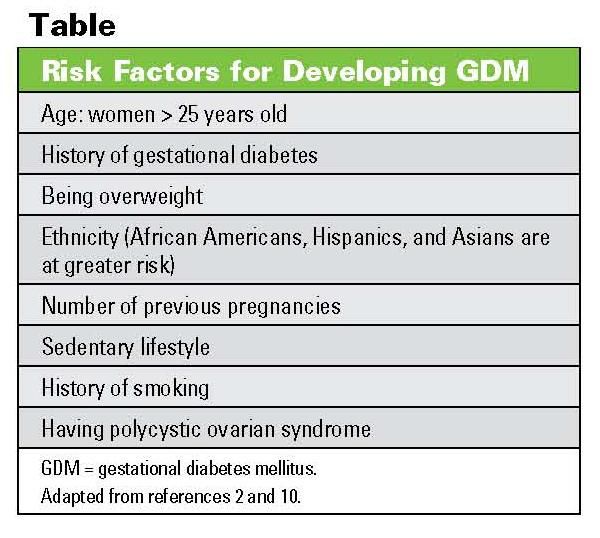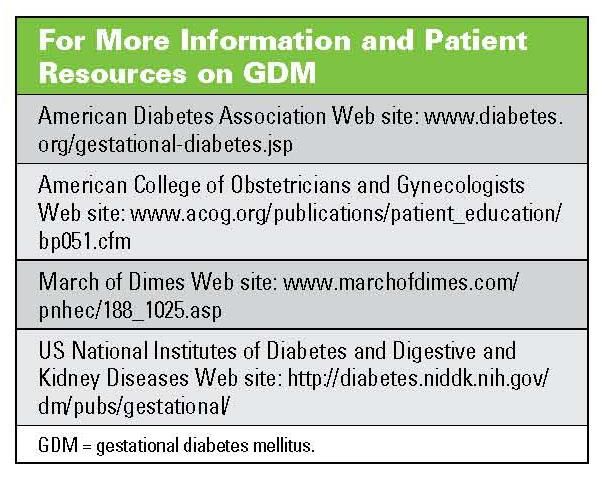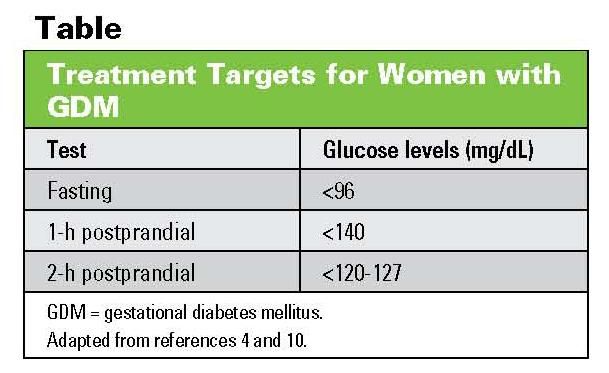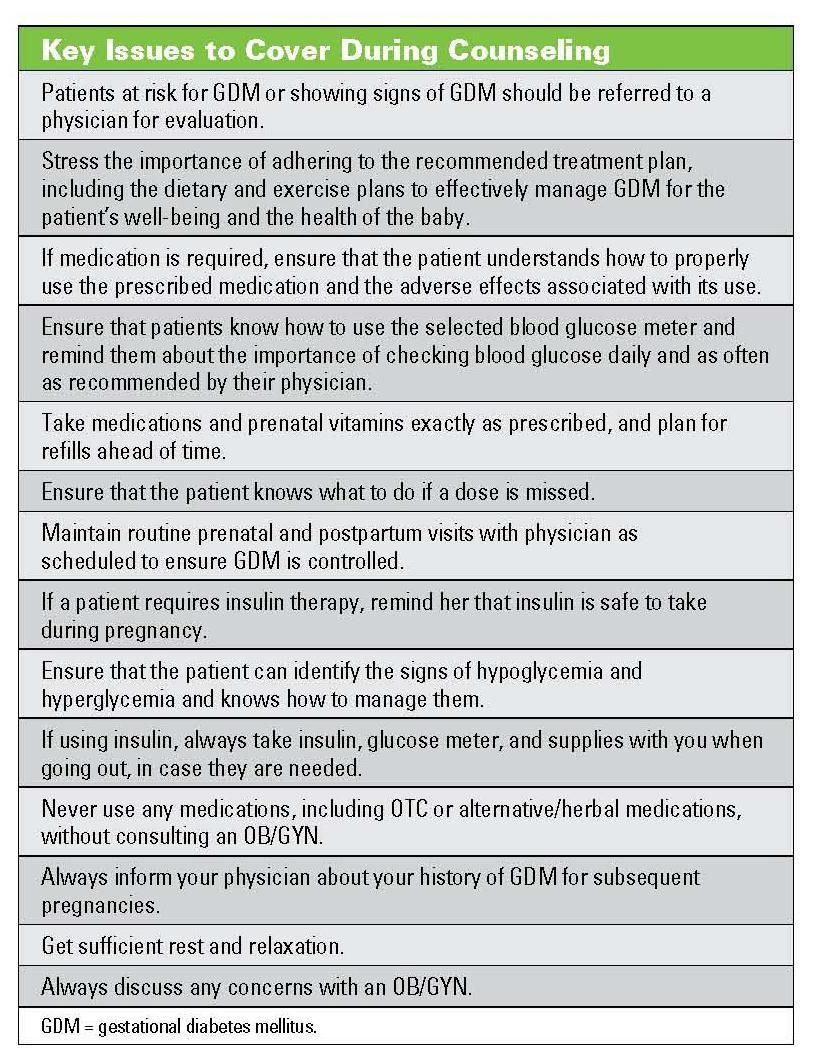Publication
Article
Pharmacy Times
Gestational Diabetes: What Patients Need to Know
Author(s):
Ms. Terrie is a clinical pharmacy writer based in Haymarket, Virginia.
Pharmacists are likely to encounter patients who are at risk or have been diagnosed with gestational diabetes and should be prepared to counsel these patients as well as provide them reassurance in order to successfully manage this condition. Gestational diabetes mellitus (GDM) is defined as carbohydrate intolerance of variable severity with onset or first recognition during pregnancy and does not include women who had diabetes prior to conception.1,2 GDM occurs in an estimated 7% to 9% of pregnant women, representing 200,000 cases annually.3,4 Gestational diabetes initially becomes apparent after 24 to 28 weeks of pregnancy, but can continue in some women after delivery.1,4
GDM is associated with both maternal and perinatal complications.5 If left untreated, gestational diabetes can pose serious

health consequences for both the mother and infant.5 Women with GDM are at risk for the development of hypertensive disorders, and perhaps the most common complication that can affect the infant is macrosomia, which is defined as an infant weighing more than 9 lb.6,7 In addition, GDM increases the mother’s risk of preeclampsia, cesarean delivery, and type 2 diabetes in the future. An estimated 50% of women who have GDM will develop type 2 diabetes within 5 to 10 years.4
With regard to the infant, GDM also is associated with increased rates of perinatal mortality, birth trauma, hyperbilirubinemia, and neonatal hypoglycemia. Some studies report an association between GDM and increased perinatal mortality rates, but other studies have shown no increased risk.6,7
The American College of Obstetrics and Gynecology (ACOG) recommends screening and treatment of gestational diabetes.8 The ACOG recommends considering screening obese pregnant women for GDM during the first trimester and repeating it later in pregnancy if initial screening is negative.9 It has been demonstrated that good metabolic control maintained throughout pregnancy can reduce maternal and fetal complications in diabetes.2
Although any pregnant woman can develop GDM, certain risk factors may increase a woman’s chances of developing GDM (see www.PharmacyTimes. com/CounselingGDM for this list).
American Diabetes Association Standards of Care
According to the 2009 standards of care from the American Diabetes Association (ADA), women at very high risk for GDM should be screened for diabetes as soon as possible after the confirmation of pregnancy.3,7 In addition, all women with a greater-thanlow risk of GDM, not found to have diabetes early in pregnancy, should undergo GDM testing at 24 to 28 weeks of gestation.3,7,10 Low-risk status, which does not require GDM screening, is defined as women with all of the following characteristics: younger than 25 years of age; normal weight before pregnancy; member of an ethnic group with a low prevalence of diabetes; no known diabetes in first-degree relatives; no history of abnormal glucose intolerance; and no history of poor obstetrical outcome.3,7,10
More information on the ADA's standards of care for GDM can be found on the Diabetes Care Web site at http://care.diabetesjournals.org/content/30/Supplement_2/S2512.full.
Treatment
Results from various studies have concluded that proper treatment has a significant impact on the health of both mother and child. In general, the management and treatment of GDM involves a multifaceted approach, including the incorporation of routine blood glucose monitoring, dietary changes, exercise, and medication, if warranted. In general, GDM can be controlled through a proper diet and exercising regularly, but sometimes a woman with GDM may require treatment with insulin.5
Dietary Modification and ExerciseDietary medication, also referred to as medical nutritional therapy, is typically the initial therapy for GDM and, when possible, a dietitian/nutritionist is consulted to design a dietary plan. Whether medication is required, diet is considered to be the mainstay of treating GDM. Once a dietary plan has been determined, it is important for patients to routinely monitor blood glucose to ascertain the effectiveness of the plan. The ADA recommends a diet that adequately meets the needs of the specific patient while restricting carbohydrates to 35% to 40% of daily caloric intake.6
If appropriate, moderate exercise also is incorporated in the management of GDM.4 Studies have shown that women who are physically active before and during pregnancy are also less likely to develop GDM.6
Pharmacologic Therapy
When diet and exercise fail to maintain desired blood glucose levels, insulin is considered as the standard pharmacologic therapy used in GDM. It is estimated that 15% of women with GDM require the use of insulin.11 Pharmacotherapy also is indicated in the setting of elevated fasting glucose levels, because dietary modification has little effect on these levels.4,10,11 It is important that patients are adequately counseled on the proper administration of insulin, whether using syringes or prefilled insulin pens. Key topics to cover during patient counseling include preparing for the shot, including necessary supplies, checking dosage and expiration date before administration, proper injection technique for administering the insulin, disposal after completion of injection, and proper storage of insulin. It is important to ensure that patients understand how to measure blood glucose and know how often they should test throughout the day.
Oral Hypoglycemics
The use of oral hypoglycemic agents for the management of GDM has gained popularity over the past few years. Some studies have demonstrated that glyburide is safe to use during pregnancy and that it provides glucose control comparable to that of insulin for women with GDM.4,7 Due to the relatively small number of patients in these studies, the absolute safety of this agent has not yet been proven, and debate about whether it crosses the placenta also exists.4 In some cases, glyburide is used as an alternative to insulin therapy and sometimes used as first-line therapy.4
Metformin may also be another option for managing GDM, particularly for women with polycystic ovarian syndrome. The Metformin in Gestational Diabetes (MiG) trial randomly assigned 751 women with GDM at 20 to 33 weeks of pregnancy to open treatment with metformin (with supplemental insulin if necessary) or to insulin alone.4,12 The results reported that treatment with metformin when compared with the use of insulin was not associated with increased perinatal complications in women with GDM, and the study participants preferred the metformin.4,12
Several clinical trials are currently investigating the use of metformin in GDM. More information about these trials can be found at www.clinicaltrials. gov/ct2/results?term=metformin+and+gestational+diabetes. Currently, the ACOG and the ADA do not recommend oral hypoglycemic agents as a treatment for GDM due to concerns regarding safety and the need for studies.2
Conclusion

Pharmacists are in a pivotal position to remind pregnant women and even those contemplating pregnancy, especially those at greater risk of developing GDM, about the importance of receiving early prenatal care and continuing care throughout their pregnancy. Patients with GDM should be reminded to adhere to the recommended treatment plan for both their overall well-being as well as that of their unborn child.
In general, GDM patients should test their blood glucose levels at least 6 times a day (before each meal and 1 hour after each meal). Patients should also be encouraged to adhere to the recommended dietary plan and, if appropriate, a routine exercise regimen, if approved by an obstetrician. Most patients do not require insulin postpartum, but should have glucose levels monitored and be encouraged to follow up with their physician after delivery. Regular screenings for type 2 diabetes should be encouraged. The Diabetes Prevention Program recommendations to promote weight and decrease the risk of type 2 diabetes include breast-feeding and establishing a diet plan for specific weight loss and an exercise regimen of at least 150 minutes per week.4,13,14










